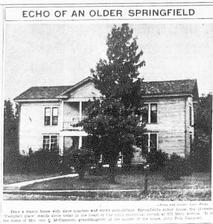Campbell House
 ‘Campbell Place’ is Oldest House in Springfield
‘Campbell Place’ is Oldest House in Springfield
Springfield News and Leader September 26, 1937, page E12.
"On a dusty side street, half hidden in bushes and shade trees, is Springfield’s oldest residence, a big white southern Colonial. A visitor might have difficulty finding it; you may have lived in Springfield for years without even knowing of its existence, yet the history of the town and the house are so closely interwoven it would be impossible to separate the two.
"Today it stands sturdily in quiet seclusion at 973 Mary Avenue, where it was moved in 1921 from the site now occupied by Jarrett Junior high school. Old timers call it the ‘Old Campbell place’ and ‘old Owens place.’ Today it is the home of Mrs. John P. McCammon, whose grandfather, John Polk Campbell, built it.
"The remarkable thing is the way the house has withstood the years, considering how it has been modified, remodeled and moved about. The house was built in 1850-51 by one Joseph Gott, early-day contractor, for John Polk Campbell who had left Springfield four years before to operate a large plantation in the Caddo Lake region of Texas. ‘Major’ Campbell and his wife didn’t like it in Texas. Campbell had liked this region since 1828 when he first came here and carved his name on a tree, later built a log house where Barth’s store now stands on the square, still later gave 50 acres to form the townsite.
"Campbell’s orders were for Gott to duplicate the old William Polk home near Columbia, Tenn., but in that respect it was a failure. The house originally had six fireplaces--one for each of the large rooms--and, true to southern style, a detached kitchen and smokehouse. There were four two-room cottages for field hands and servants, barns were south of the south orchard.
"The family moved in in 1852 but Major Campbell, who came out of the Mexican war a sick man, lived only long enough to superintend the planting of the orchards and the black locust trees on the lawn. Mrs. Campbell dubbed the place ‘Wild Haunt’ for the way winter blasts whistled around the white clapboard corners and through the pillared portico.
"Campbell place was not more than 10 years old before the family was ordered out by the Union army. It was converted into a military headquarters until after the battle of Wilson Creek in 1861. Four of the Campbell boys were fighting with the Confederate army at that time. Later General Marmaduke, Confederate leader, used the house for a hospital. The orchards and graveyards were filled with Confederate dead. The house was often in the line of fire.
"In the meantime Sarah Campbell, Mrs. McCammon’s mother, had married Jabez Owens who owned a large farm nearby part of which is now Fassnight Park. The Owens were ordered out too during the war, returning after it was over to find eight families lining in Campbell place, others crowded in the kitchen and servants cottages. Southern sympathizers were unpopular then, and it was with some difficulty that Mrs. Campbell was restored her property. After Mrs. Campbell’s death the property was divided, after which Owens lived in it.
"After the war the place was for a time overrun with treasure seekers. Rumor had it that a fortune was buried somewhere on the Campbell place and large holes were dug around the foundation, under the floors and out in the orchards in a vain effort to find the treasure. For a short time after the army vacated the house, Mrs. John S. Phelps, wife of the early day governor, used it for an orphans’ home.
"A building boom occurred in the seventies [1870's]. The kitchen, storeroom, and the cottages were moved to new sites and used for rental property. The ice house and milk house were moved to Grand and Jefferson, later destroyed by fire.
"When Lucy Campbell Owen married John P. McCammon, Springfield lawyer, they came to live in the house. In 1905 the house was raised to accommodate a furnace large enough to heat the six large rooms, and the five small ones. At that time the stairways were changed. Four of the six fireplaces were taken out. As a gift to his wife, McCammon had an oak stairway installed, oak paneling in the dining room, two mantels and oak woodwork in three of the rooms. Mr. McCammon died in 1931.
"In 1921 all the frontage on Jefferson was sold to the school board and Campbell house was moved to the present location on Mary Avenue. Considering that the house is 52 feet square and considerably weakened by alterations, moving the house to its present site undamaged was no mean feat."
According to John Rutherford, Local History and Genealogy Associate, the modern address would be on Roanoke Ave. between Madison and Grand streets.
Learn more about the Campbell house during the 1863 Battle of Springfield at: www.springfield1863.org.
Find this article at http://thelibrary.org/blogs/article.cfm?aid=2983&lid=0&view=print